A microchip implant is a passive RFIDdevice. The device lacks internal power source, it remains inert until it is powered by a scanner in the event that the animal / pet needs to be identified. Once the microchip is implanted, an enrollment form is completed with chip ID, owner contact information, pet name and description, veterinarian contact information, and an alternate emergency contact designated by the pet owner.
Animal microchip / pet microchip implantation is the first thing one needs to do once adopting a pet. Even before the vaccination! Animal shelters, animal control officers and veterinarians routinely look for microchips to return lost pets quickly to their owners.
Some countries require microchips on home pets or on certain types of pets.
Every pet owner needs the insurance that if his/her pet ever gets lost – it will be located ASAP. The microchip is the patent that provides that peace of mind. Pet owners sign their pets at the microchip registration center in their country / state, trusting that if their pet ever gets lost, it will be found nearby. But when traveling abroad with their pets at a global level, they need to take extra precautions. In order to make sure their pet could be traced and returned safely, they need to make sure: 1. that the microchip that was implanted is according to the international standard. 2. that the microchip is readable (that non of the digits are missing).
When moving a pet to a new country or state, it is highly recommended to check the local policies regarding pets’ registration policy and to make sure that the pet is “in the system” at its’ new domain.
If you are planning to relocate with your pet, call our flight veterinarians for professional advice and guidance.

